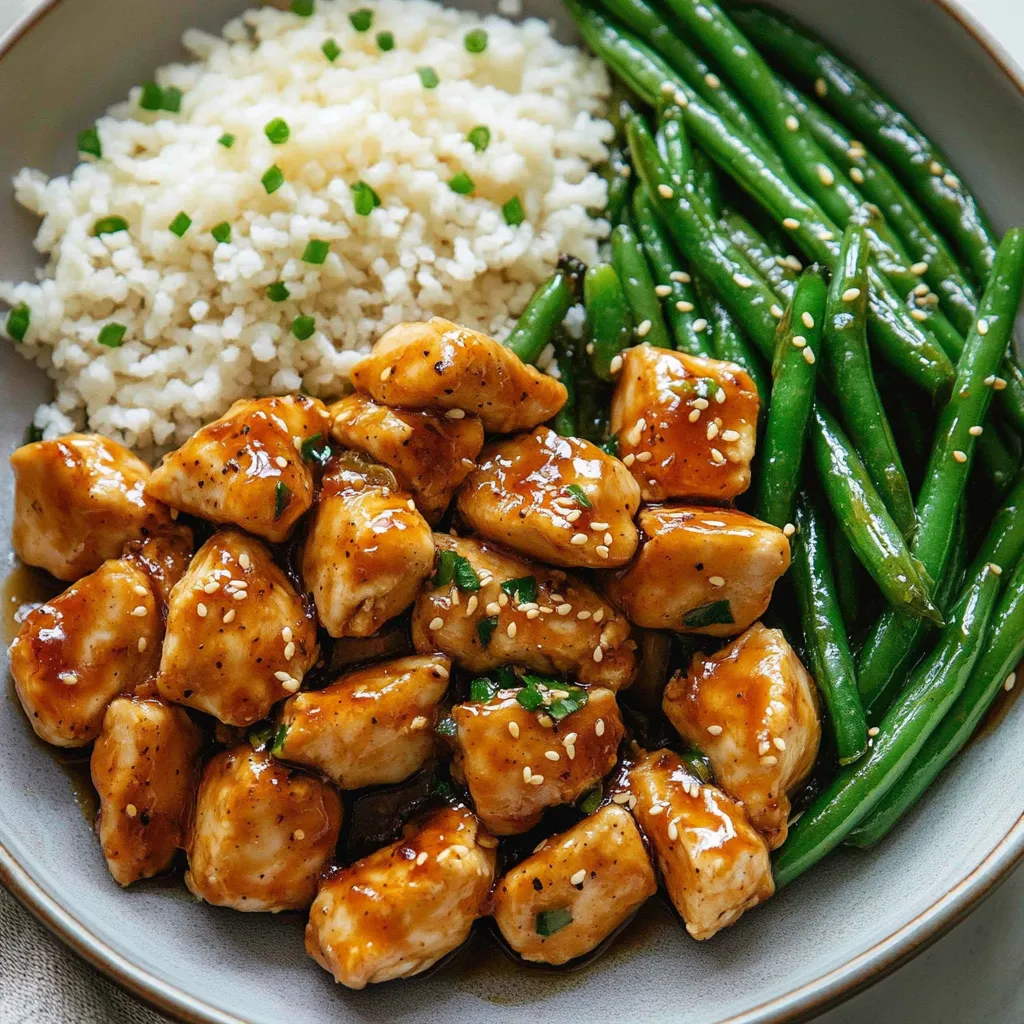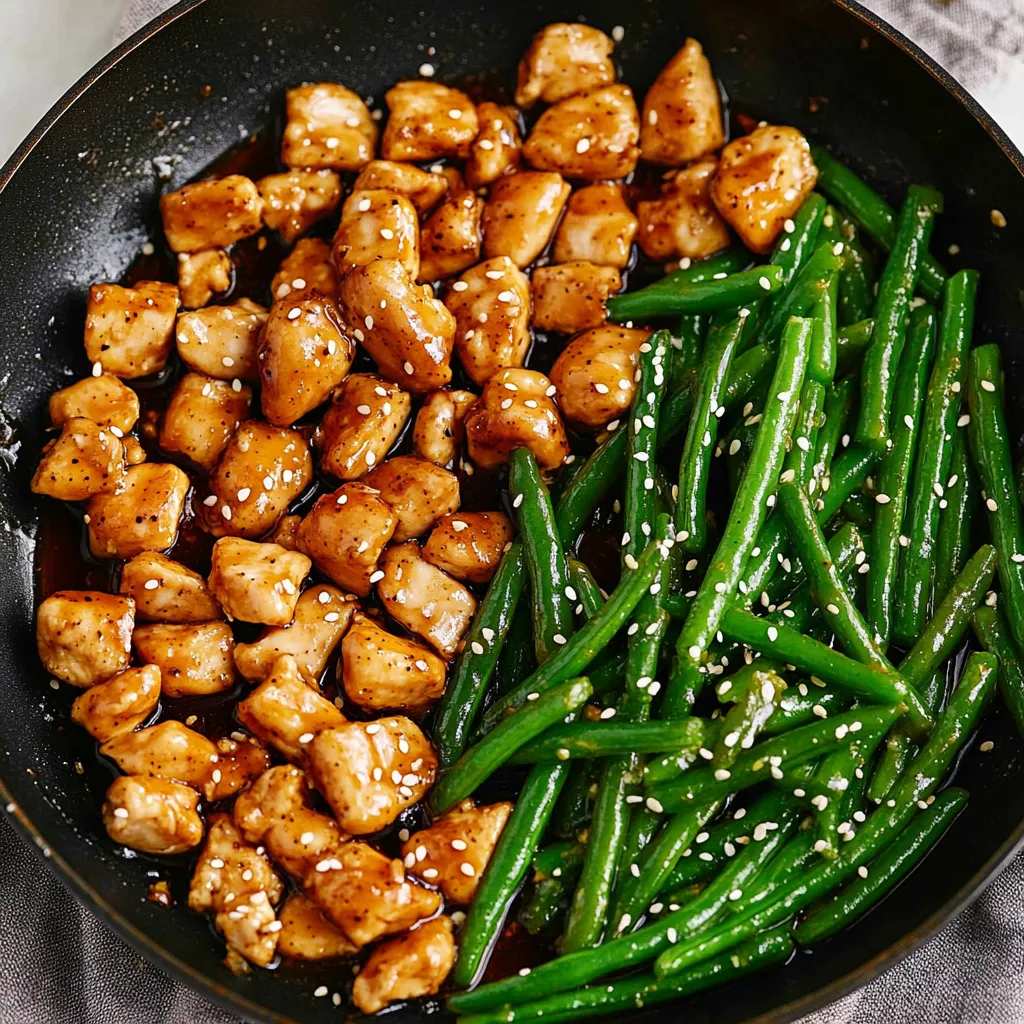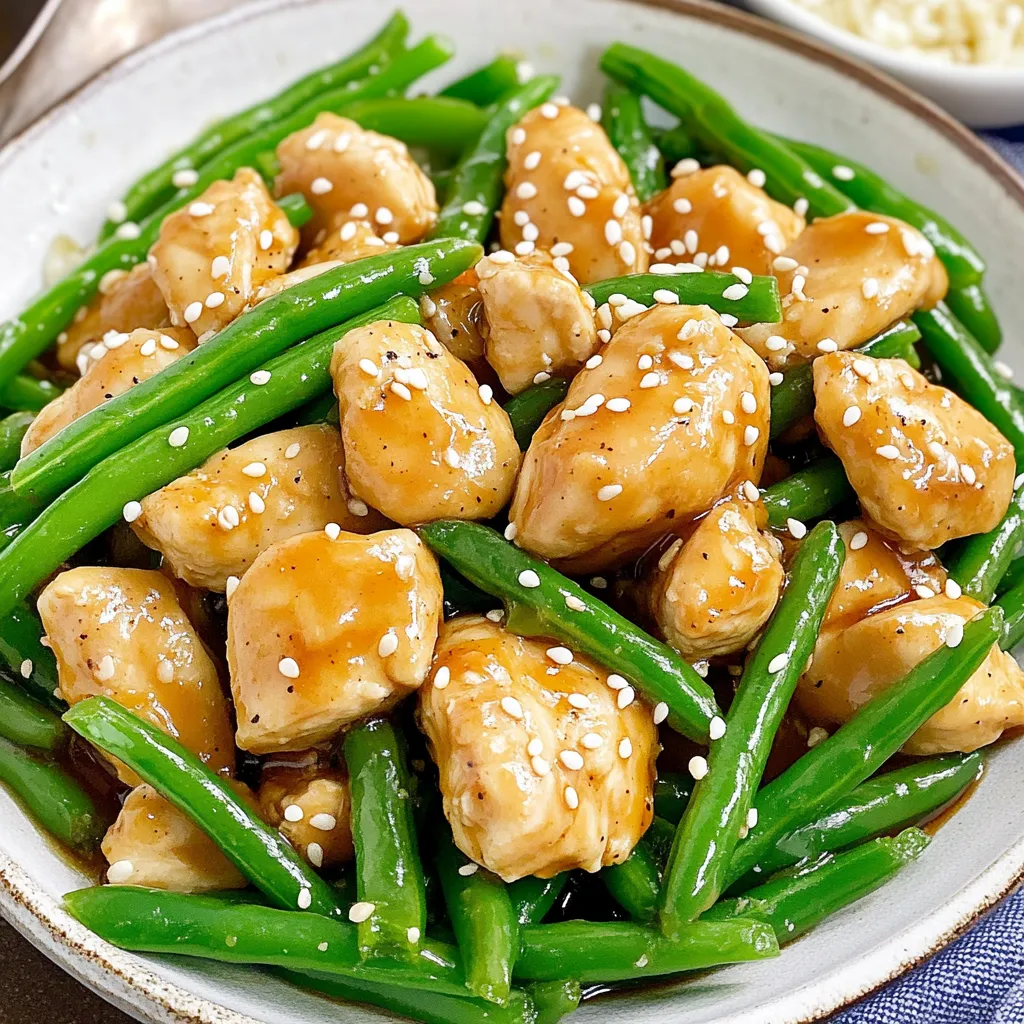 Pin it
Pin it
This mouthwatering honey garlic chicken transforms ordinary chicken and green beans into an extraordinary meal that rivals your favorite takeout. The magic happens when tender chicken pieces with their light, crispy coating soak up the sticky, savory-sweet sauce while fresh green beans provide the perfect crisp contrast in texture. Unlike many restaurant versions loaded with sugar and sodium, this homemade version delivers authentic flavor from natural ingredients while staying on the table in less than 30 minutes – perfect for satisfying weeknight cravings without the guilt or wait of delivery.
My family discovered this recipe during a particularly hectic season when takeout had become our unhealthy habit. The first time I made it, my husband actually stopped mid-bite to ask if I'd secretly ordered food. My children, typically suspicious of anything green, actually fought over the last green beans! Now it's requested weekly, and I keep the ingredients on hand as my secret weapon against the temptation to order in when life gets busy.
Essential Ingredients
- Boneless Skinless Chicken Breasts: The perfect protein canvas for absorbing the honey garlic flavors. Cut pieces uniformly to ensure even cooking and maximum tenderness. Dark meat lovers can substitute thighs for even juicier results with richer flavor notes.
- Fresh Green Beans: These provide essential texture contrast and vibrant color. Fresh beans maintain their snap when cooked properly, unlike canned versions that quickly become mushy. Look for bright, firm beans without blemishes, and trim just before cooking to preserve their freshness.
- Olive Oil: Creates the foundation for both cooking the chicken to golden perfection and sautéing the green beans. The slight fruitiness of good olive oil adds subtle depth to the final dish. Cold-pressed varieties offer the cleanest flavor profile.
- Honey: The star sweetener that creates that irresistible glaze without refined sugar. Local honey not only supports nearby beekeepers but often brings unique floral notes that add complexity to the sauce. Its natural thickness helps the sauce cling beautifully to every bite.
- Fresh Garlic and Ginger: The aromatic foundation that transforms this dish from good to extraordinary. Pre-minced versions simply can't compare to the vibrant, complex flavors of freshly prepared aromatics. Their volatile oils release during cooking, creating that unmistakable fragrance that signals something delicious is happening.
- Arrowroot Powder: Creates the light, crispy coating on the chicken that helps it brown beautifully while protecting its moisture. This natural thickener also gives the sauce its perfect consistency without the chalky taste sometimes found with cornstarch.
- Soy Sauce: Provides the essential umami foundation and saltiness that balances the honey's sweetness. Low-sodium varieties allow you to control the final salt level while still delivering that distinctive fermented soy flavor.
Step-by-Step Cooking Instructions
- Prepare your chicken for maximum flavor absorption -
- Cut 3 boneless skinless chicken breasts into 1-inch cubes, ensuring uniform size for even cooking. In a medium bowl, whisk together 1 tablespoon arrowroot powder, 1 teaspoon garlic powder, 1 teaspoon onion powder, ½ teaspoon salt, and ¼ teaspoon black pepper. Add chicken pieces and toss thoroughly until each piece has a light, even coating. This crucial step creates a protective layer that will brown beautifully while sealing in moisture and providing texture that helps the sauce cling to each piece.
- Achieve the perfect golden sear -
- Heat a large skillet over medium-high heat and add 1 tablespoon olive oil, swirling to coat the surface completely. Once the oil shimmers but before it smokes, carefully add the coated chicken pieces in a single layer, giving them enough space to brown rather than steam. Allow them to cook undisturbed for 2 minutes before stirring to develop that crucial golden crust. Continue cooking for another 2-3 minutes, stirring occasionally, until the chicken is just cooked through with a beautiful amber exterior. Transfer to a clean plate, leaving any browned bits in the pan – these flavor remnants will become part of your sauce's complexity.
- Perfect the green bean texture -
- Without washing the skillet (those browned bits are flavor gold!), add another tablespoon of olive oil and allow it to heat briefly. Add 1 pound of trimmed fresh green beans, season with a pinch of salt and pepper, and arrange in an even layer. Allow them to sit undisturbed for 1-2 minutes to develop slight charring before stirring. Continue to cook for 4-5 minutes total, stirring occasionally, until the beans develop spotted caramelization while maintaining their bright color and crisp-tender texture. They should still have substantial snap when bitten – nobody wants mushy green beans!
- Craft your signature sauce -
- While the green beans cook, create your sauce by whisking together ½ cup low-sodium chicken broth, 3 tablespoons low-sodium soy sauce, 3 tablespoons honey, 4 cloves minced fresh garlic, and 1 tablespoon freshly grated ginger in a bowl until fully combined. In a separate small bowl, create your thickening agent by mixing 2 teaspoons arrowroot powder with 2 teaspoons water until completely smooth with no lumps. This two-step approach prevents clumping and ensures silky sauce texture.
- Create the perfect sauce consistency -
- Once the green beans reach their ideal texture, return the chicken to the skillet and toss to combine. Pour the honey-garlic sauce mixture over everything, stirring to coat all ingredients evenly. Bring the liquid to a gentle boil, then stir in the arrowroot slurry. Reduce heat to medium-low and simmer for 2-3 minutes, stirring frequently as the sauce thickens and becomes glossy. The perfect consistency should coat the back of a spoon but still flow, creating a luxurious glaze that clings to both chicken and green beans.
- Finish with fresh elements -
- Remove the skillet from heat and sprinkle with 3 tablespoons sliced green onions and 1 teaspoon sesame seeds. These finishing touches add brightness, color contrast, and texture variation that elevate the final presentation. Allow the dish to rest for 1-2 minutes before serving to let the flavors settle and the sauce reach its ideal consistency. This brief resting period is the difference between good and spectacular results.
 Pin it
Pin it
The One-Pan Wonder Revolution
The brilliance of one-pan cooking extends beyond simple convenience. When protein and vegetables cook in the same pan, they exchange flavors in ways that separate cooking simply cannot achieve. The chicken releases its savory juices, which the green beans then absorb, while the beans contribute their earthy freshness to the overall dish profile.
This cooking method also creates something professional chefs prize above all: fond, those caramelized bits that develop on the pan's surface. As the sauce deglazes these flavor-packed treasures, they dissolve and distribute throughout, creating remarkable depth that makes diners wonder what special ingredient they're tasting.
My kitchen experimentation journey began years ago when trying to recreate my grandmother's recipes. She never measured anything yet produced consistent, delicious results. I've discovered her secret was understanding how ingredients interact and building flavors in layers – exactly what this one-pan method accomplishes.
When my sister-in-law requested this recipe after a family dinner, she couldn't believe how simple it was given the complex flavor. Now it's become her go-to for impressing dinner guests who inevitably ask for the recipe themselves. There's something uniquely satisfying about sharing a dish that tastes complicated but is actually quite straightforward to prepare.
Asian-Inspired Cooking Essentials
The beauty of Asian-inspired cooking lies in its balance of sweet, salty, sour, and umami flavors. This honey garlic sauce exemplifies this perfect harmony with honey providing sweetness, soy sauce contributing salt and umami, garlic offering pungency, and ginger providing that distinctive warmth.
Traditional Chinese cooking techniques often include velveting – coating protein in cornstarch before cooking – which is similar to our approach with arrowroot powder. This technique protects delicate meat from tough, dry texture while creating a sublime mouth-feel in the finished dish.
When my husband and I traveled through Asia several years ago, we took cooking classes wherever possible. The most valuable lesson wasn't specific recipes but understanding how to balance contrasting elements. This honey garlic sauce represents that philosophy perfectly, with each component playing a crucial role in the symphony of flavors.
My mother always added a touch of honey to her stir-fries, a trick she learned from our Chinese neighbor growing up. She explained that honey doesn't just add sweetness – it helps other flavors bloom and creates that coveted glaze that makes restaurant dishes so irresistible. It's become my secret ingredient in countless dishes beyond this one.
 Pin it
Pin it
My personal discovery came when experimenting with different sweeteners in this dish. I tried maple syrup, which created a woodsier undertone that paired beautifully with autumn vegetables. Brown sugar worked well but lacked the complexity of honey. Agave made the sauce too thin. Eventually, I settled on a local wildflower honey from our farmers market that adds subtle floral notes you simply can't get from processed sweeteners. It's these small personal touches that transform a good recipe into your signature dish.
After years of home cooking and endless tweaking, I've learned that proper heat management makes all the difference in stir-fry-style dishes. Starting with a properly preheated pan creates that essential caramelization without overcooking the delicate ingredients. I keep my large cast iron skillet exclusively for dishes like this – it's developed a seasoning that adds subtle depth to everything cooked in it. When my daughter left for college, her parting request wasn't for money or clothes but for my "secret" honey garlic recipe. I wrote it on a card that now hangs on her dorm room wall, a simple comfort she can recreate whenever homesickness strikes. That's the true power of a reliable, delicious recipe – it becomes more than food; it becomes connection.
Frequently Asked Questions
- → Can I use chicken thighs instead of breasts?
- Yes! Boneless skinless chicken thighs work great in this recipe and stay even juicier than breasts.
- → What can I substitute for arrowroot powder?
- Cornstarch works perfectly as a 1:1 replacement for arrowroot powder in this recipe.
- → Is this recipe gluten-free?
- Not as written, but you can easily make it gluten-free by using tamari or certified gluten-free soy sauce.
- → Can I add other vegetables?
- Absolutely! Bell peppers, broccoli, or snap peas would all work well. Just adjust cooking times accordingly.
- → How long will leftovers keep?
- Store leftovers in an airtight container in the fridge for up to 3 days. Reheat gently in a skillet or microwave.
- → Can I make this spicy?
- Yes! Add red pepper flakes or sriracha to the sauce for some heat.
